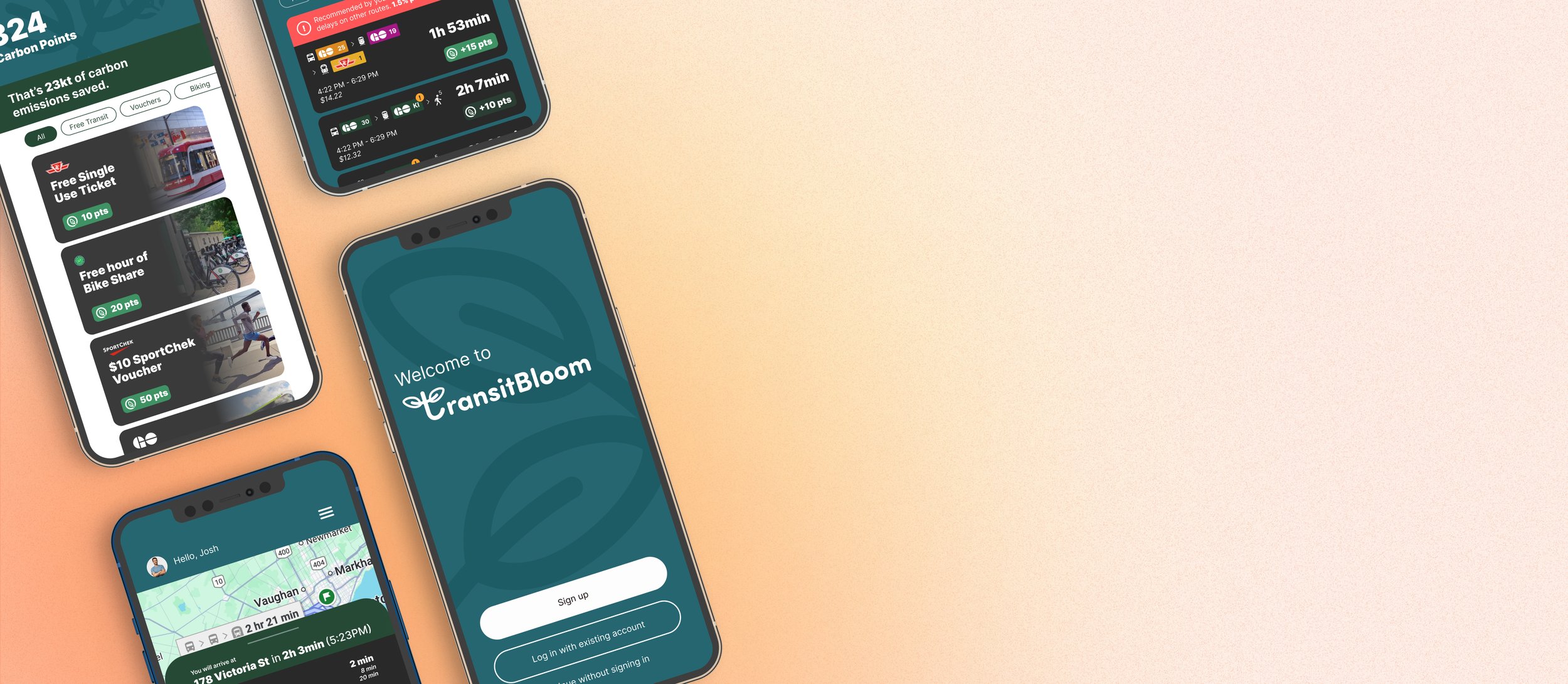TransitBloom: Smarter Sustainable Travel
Designing an app that empowers commuters with efficient, eco-friendly, and accessible transit solutions all in one place.
tags
tag #2
Transit Bloom Case Study
UI Design *tags
View Full Prototype
OVERVIEW
Reimagining the Daily Commute for a Greener Future
As my partner and competed in a UXLaurier design challenge, we aimed to address a common and increasing problem: how to make commuting more efficient, inclusive, and environmentally conscious.
The prompt challenged us to rethink how commuters interact with transit systems. Through user-centered research and digital design, we set out to create a solution that supports efficient, eco-conscious commuting for all.
DESIGN CHALLENGE
How might we design sustainable travel options that increase efficiency while enhancing the quality of life for daily commuters?
SOLUTION
Create a commuter-focused app where users can plan sustainable routes, earn points for eco-friendly travel, view accessibility options, and enjoy a personalized, streamlined commuting experience.
SOLUTIONS
TransitBloom
Users earn points for choosing low-emission routes like biking, walking, or public transit. Points can be redeemed for transit discount or local deals— encouraging repeat consumer behaviour.
Why aren’t people choosing sustainable transit— even when they want to?
EMPHATHIZE
Project type: Design challenge
Methods: Wireframes, Logo creation, Mood board, Responsive Design, Prototype
SOLUTION 1
Smart Route Planning
Offers real-time transit updates and personalized, low-emission route suggestions. Helps users avoid delays and choose faster, greener options.
SOLUTION 2
Eco-Points Rewards System
SOLUTION 3
Accessibility Filters
Role: UX Research, Interaction Design
Duration: Nov 24 (48 hour design challenge)
Tools: Figma, Adobe Photoshop, Adobe Illustrator, Procreate
To design an effective solution that improves sustainable commuting, we needed to understand what truly gets in the way of sustainable commuting. Our research focused on the daily experiences of two primary groups: students who prioritize speed and cost, and seniors who require accessible routes. Through competitor analysis, market data, and user insights, we explored how people make transit decisions and what deters them from using options that are already available.
RESEARCH GOALS
Identify daily commuting pain points (e.g., congestion, delays, accessibility)
Understand what motivates or discourages sustainable travel
Understand how costs and incentives influence consumer behaviour
Examine importance of catering to the needs of those with limited mobility
KEY FINDINGS
Transit schedules are confusing and hard to trust
Accessibility is still a major barrier, discouraging users with mobility needs
Users are open to eco-friendly options if rewarded or made easier
There is a growing public interest in sustainability, but it is not enough to drive action alone
USER INSIGHTS
“Bus schedules are so confusing— I never know when to leave.” - International student
“Sometimes there’s no elevator at the stations. It’s just stairs. How am I supposed to get up?” - Senior commuter
“If I had a reason— like discounts or points— I might actually drive way less.” - Occasional transit user
Filters routes based on mobility needs like elevators, ramps, or sensory-friendly paths. Makes commuting safer for users with disabilities or accessibility concerns.
DEFINE
Turning barriers into design opportunities
It became clear that most commuters aren’t opposed to sustainable travel— they just don’t feel supported. TransitBloom needed to fill the gap between intention and action with an app that makes sustainability accessible, logical, and rewarding.
PROBLEM STATEMENT
Commuters face unreliable, inaccessible, and uninspiring transportation options. They need a system that makes sustainable travel easier, more rewarding, and more aligned with their personal needs.
DESIGN GOAL
Design a digital experience that provides:
Real-time, clear route planning
Support for users with accessibility needs
Gamified incentives to encourage eco-conscious habits
HOW MIGHT WE…
Make daily commuting decisions feel informed and intuitive?
Motivate greener habits through positive reinforcement?
Design features taht accommodate diverse mobility needs?
03 PROTOTYPE & TESTING
Refining the experience through feedback, iteration, and visual clarity
With early feedback, we learned that our initial design did not visually reflect our mission, and some key features were not intuitive enough. Iterative testing helped us refine our designs better to support our goals and communicate value.
LOW-FIDELITY PROTOTYPES
We gathered feedback on usability and visual direction. Key pain points included:
The purple UI theme did not align with our sustainability message
Users felt overwhelmed by how information was grouped
Accessibility filters were buried or unclear
HIGH-FIDELITY PROTOTYPES
We created a green-teal palette to reflect eco-consciousness and added intuitive icons. Based on tester input, we included:
Carbon-saving stats to increase engagement
A reward system to incentivize green behaviour
Clear accessibility toggles and route preferences
TESTING INSIGHTS
Gamified elements (eco-points) drove engagement
Users responses better to concise, icon-led navigation
Accessibility features were easy to understand and valued
The refined colour system helped users connect with the app’s mission

